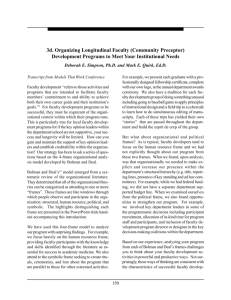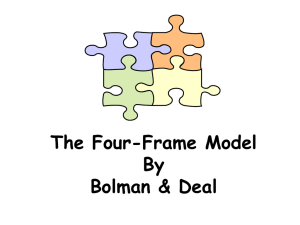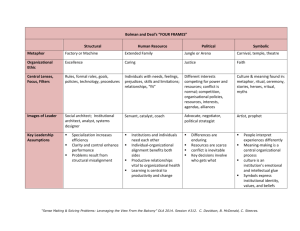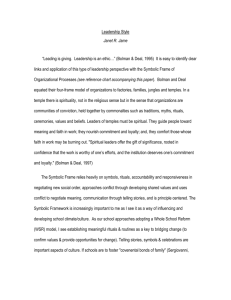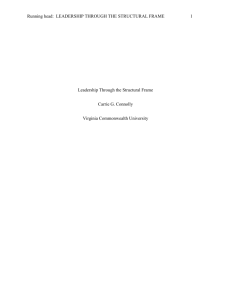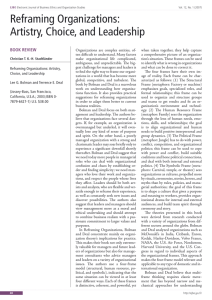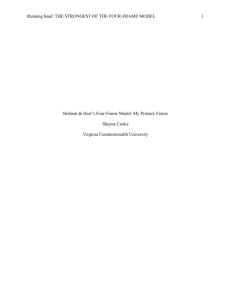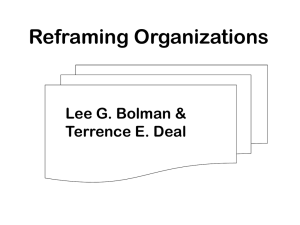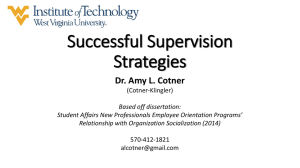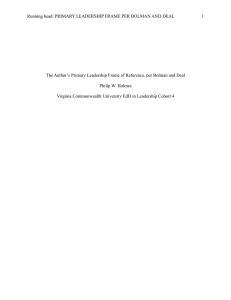Paper 1 Leadership Orientation-Primary Leadership Frameworks 10
advertisement
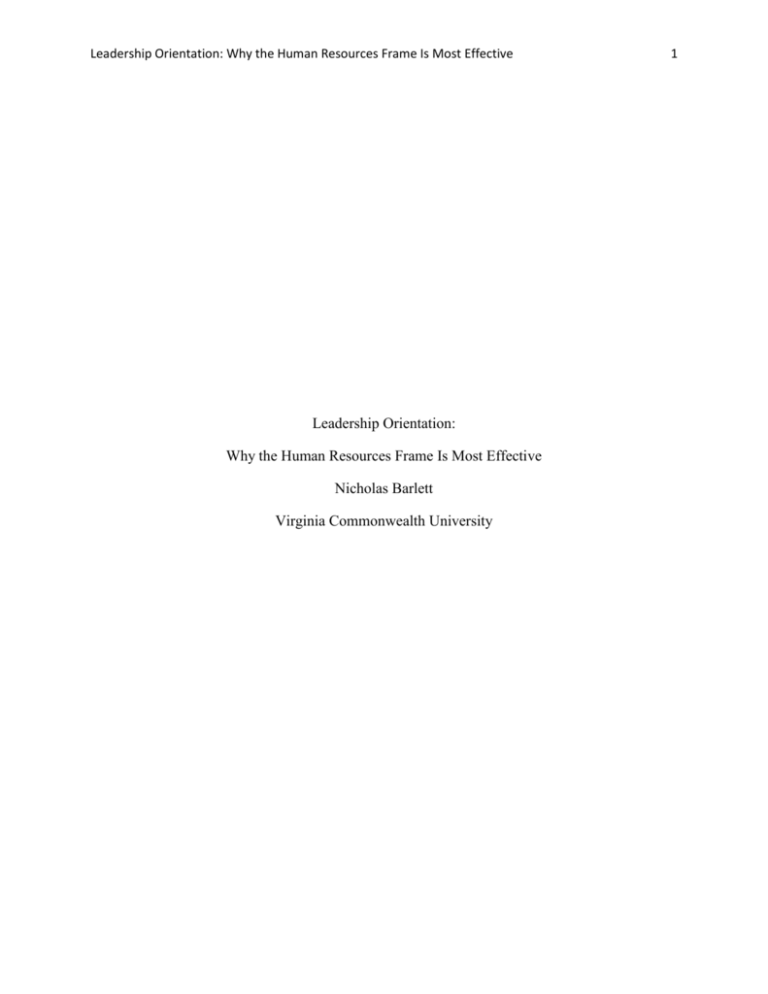
Leadership Orientation: Why the Human Resources Frame Is Most Effective Leadership Orientation: Why the Human Resources Frame Is Most Effective Nicholas Barlett Virginia Commonwealth University 1 Leadership Orientation: Why the Human Resources Frame Is Most Effective 2 Abstract The mechanics of great leadership are complex to understand but if one were to try to understand the concepts it must be simplified into frameworks that are more comprehendible. The leadership frameworks described by Lee Bolman and Terrence Deal (2008) provide a reference for understanding what other leaders have done correctly and incorrectly in their leadership roles. Using this framework allows for readers to understand the motivation and viewpoints of other but it also allows readers to gain a better understanding of one’s own leadership style and frame of reference when dealing with challenges. This article will explain the merits and the pitfalls of the structural, human resources, political and symbolic frameworks of Bolman and Deal and establish why the human resources frame is the most effective. Leadership Orientation: Why the Human Resources Frame Is Most Effective Leadership Orientation: Why the Human Resources Frame Is Most Effective Understanding one’s own leadership style is essential to growing as an effective leader. This level of self-reflection is possible with the use of a framework that will provide a context for understanding a concept as multifaceted as leadership. Lee Bollman and Terrence Deal (2008) provide four basic types of orientation that leaders view challenges from. Everyone possesses these frameworks but there are natural inclinations toward one over another as one faces the varied challenges that arise. As the reader gains the ability to recognize these and understand which framework works best from moment to moment it is easier to achieve the leadership goals that are desired (Bolman & Deal, 2008). The ability to provide a common vision for an organization is an important leadership skill. Leaders with this ability to frame an experience so that it sets a path that has meaning and inspiration are symbolic leaders (Bolman & Deal, 2008). Wilfred Drath (2001) has established three leadership tasks that are the basis for his view of the role of leaders in any organization. Two of these three relate directly to the symbolic frame. He posits that setting direction and creating commitment are essential tasks for any leader. In the most sinister interpretation of Drath’s ideas, a leader can set a goal and convince others through person charisma and a flair for the dramatic to follow but not have the greater good in mind. An example of this is Trofim Lysenko, who used his charismatic persona and motivate supporters to rise through the ranks to run the Soviet genetic science program in spite of the fact that he was considered a pseudoscientist by the rest of the international science community (Soyfer, 1994). Lysenko was described by British biologist Cyril Darlington as “obviously illeducated, quite shallow, very cunning and a little deranged” (Li, Liu & Wang, 2009). In 3 Leadership Orientation: Why the Human Resources Frame Is Most Effective 4 instances Lysenko’s goal was his rise to power not the advancement of a common goal. These circumstances show that it is important to temper the symbolic frame with other frames. Leaders that are strong negotiators and know how to form bases of allies to help reach a goal are political leaders (Bolman & Deal, 2008). While this too is an important skill to have in the right circumstances, it is one that can be problematic if it were to be too often used. The cautionary example of Trofim Lysenko also holds important lessons about the political frame as well. Lysenko’s was able use the political tensions of the Cold War to his advantage by fitting the mold of what the Soviet polity were envisioning in a perfect mix of common sense and advance scientific study. Unfortunately for the Soviets, the political dogma of the day got in the way of true advances in science. This kept them from listening to the international scientific community and clouded their logic (Soyfer, 1994). Logic is essential in the structural framework. Structural leaders make decisions based on clear analysis and understanding of the situation. These leaders tend to be establish structures and policies that are well organized and rigid (Bolman & Deal, 2008). This framework provides an ease of use that the others do not offer. Issues have very little grey when viewed through the structural lens. This is especially convenient when having to make changes that must fall within certain rules or policies. Many leaders also have the responsibility of enforcing standards and policies. The structural framework is excellent in many of these instances because seemingly complex issues can be simplified to its core in order to make a decision. Structural frameworks fall short when the desired outcome requires dynamism and compassion. While the structural framework provides black and white decisions, leaders must not forget that we live in a world that is grey. The structural frame helps to provide order but it lacks the nuance needed to be a leader of the variety of people and situations that arise. Leadership Orientation: Why the Human Resources Frame Is Most Effective 5 An essential part of leadership is remembering that one needs the support of followers in order to reach a goal. The human resource leader understands that people make up the organization and are essential to meeting an established goal (Bolman & Deal, 2008). Through the lens of the other leadership frameworks one can still see the value of the human resources leader. Symbolic leaders can establish a goal that was created via participation from those that are being led. Mankind has seen time and again that grassroots leadership is a very successful way to achieve a goal. Leaders that use the political frame can build a coalition and achieve a goal by motivating and coaching those that she is leading. Politicians in any democracy know well that one must garner support by building strong interpersonal relationships with constituents to achieve a goal. As mentioned previously, Structural leaders are more analytical and factual but miss the nuance that comes with the role of leadership. The human resources frame can act to temper this approach and keep an organization from becoming too rigid. Due to the ability of the human resources frame to address so many areas of leadership it appears to be the leadership orientation that is most universally effective. Human resources leaders can set goals like symbolic leaders while avoiding losing focus of a common vision of those that are being led. The human resources frame can develop a support base like the political frame but there is less possibility of letting dogma get in the way of the common goal because leaders are coaching followers toward a common goal. Human resources leaders can see the nuance that structural leaders sometimes miss. While structural, political, and symbolic frames of leadership are important to utilize on a daily basis, the human resources frame allows leaders to function in multiple frames at once. Possibly most important, the human resources frame remains focused on the importance of those that are being led and their value to an organization. Leadership Orientation: Why the Human Resources Frame Is Most Effective References Bolman, L., & Deal, T. (2008). Reframing organizations: Artistry, choices, and leadership. (4th ed.). San Francisco, California: Jossey-Bass. Drath, W. (2001). The deep blue sea: Rethinking the sources of leadership. (1st ed.). San Francisco, California: Jossey-Bass. Li, B., Liu, Y., & Wang, Q. (2009). Science and politics. European Molecular Biology Organization Reports, 10(9), 938-939. Soyfer, V. (1994). Lysenko and the tragedy of soviet science. New Brunswick, New Jersey: Rutgers University Press. 6

